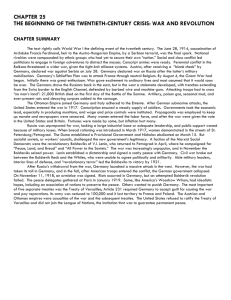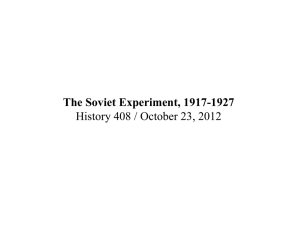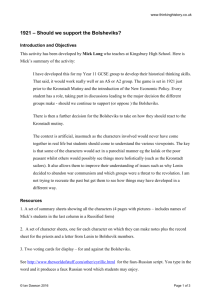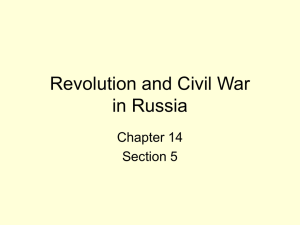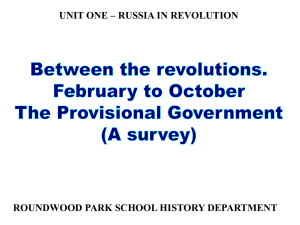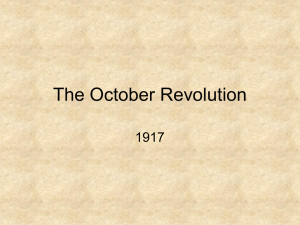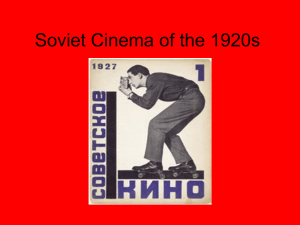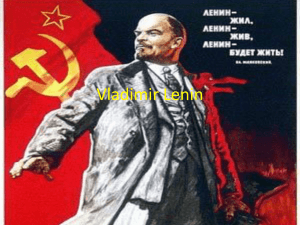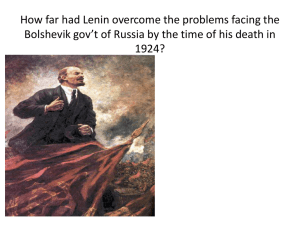Rise in Bolshevik support
advertisement
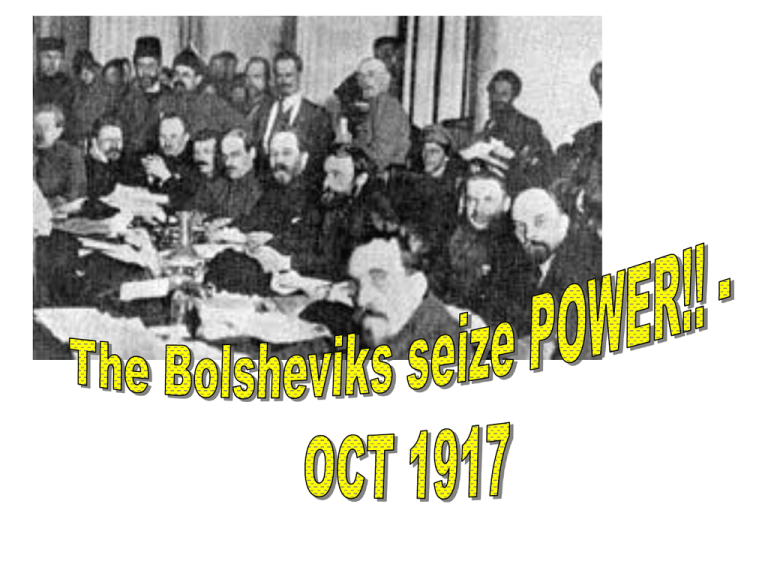
• After July days – it dropped dramatically • By Oct 1917 – situation had transformed • After Kornilov affair – Bolsheviks were not seen as the biggest threat (bigger fear of a military takeover) = as a result, Bolsheviks were seen not as a threat but as…. THE DEFENDERS OF THE REVOLUTION!! Lenin’s slogan – referred to Bol opposition to war – need to end shortages in towns and cities - referred to support for land seizures by the peasantry These slogans drew support from both industrial workers and peasantry • By the time of the Kornilov Affair – Bolshevik membership had risen to.. With the party producing across Petrograd factories. different newspapers The party had an elite force of; in Petrograd factories… This group had been able to acquire arms during the Kornilov affair. • 9 August – important announcement by PG. It proposed a timetable for national election to the Constituent Assembly. • The assembly would have the task of producing a new constitution. • Elections would be 12 Nov, with it opening 28 Nov. • Lenin knew the SRs were likely to win the most votes. If the Bolsheviks seized power, they had to do so before the elections! • Lenin developed his tactics… he suggested that all political power should be handed over to the All Russia Soviet – where the Bolsheviks had the majority. • As the PG became more unpopular, the Soviets became the one national institution which maintained respect from the population. • Lenin persuaded the Bolshevik Committee that an armed takeover of power should take place! (although two leading Bolsheviks, Kamenev and Zinoviev opposed this move) • The planning of the takeover was put in the hands of Leon Trotsky, a leading SD who had joined the Bolsheviks in May • Lenin hoped to hide Bolshevik involvement by handing over the planning to the Military Revolutionary Committee of the Petrograd Soviet. • The events which led to the seizure of power were started by the Provisional Government • 24 Oct – it attempted to close down two Bol newspapers in Petrograd. • That evening, Lenin went to Bol HQ to plan his seizure of power immediately! Because he feared the Bols were trying to clamp down on Bolshevik activity. • Using the Military Revolutionary Committee (which was under the control of Trotsky) – the Bolsheviks planned to takeover the capital on the eve of the Second Congresss of the All Russia Sovet, Oct 26. • As MRC was under Trotsky, when they seized power, they would announce they had done it on behalf of the soviet. • 24 – Oct - Red guards occupied key areas of Petrograd and arrested most of the PG who were in the Winter Palace. • The only opposition they faced was a company of women soldiers and some officer cadets who had put up minimal resistance • The PG who were arrested offered minimal resistance…. And all these activities went unnoticed by the vast majority of the population. 10am…. 25 Oct… MRC announced.. ‘The provisional government has been deposed. State power has passed into the hands of the organ of the Petrograd Soviet of Workers and Soldier’s deputies…. Long live the revolution of workers, soldiers and peasants!’ • During the morning Kerensky escaped from Petrograd by car (given to him by US Embassy) in a bid to raise loyal troops to crush the bolshevik takeover. • 25 Oct – delegate to the All Russia Soviet met. The next day Lenin was able to announce to the All Russia Soviet that the PG had been overthrown. • The 390 Bols in the All Russia Soviet were only too keen to accept Lenin’s actions. Mensheviks had only 80 seats and the SR had 180. • The All Russia Soviet therefore endorsed the Bolshevik takeover. Spring 1917, Bols unlikely to overthrow PG…before Lenins return, leading Bols (such as Kamenev and Zinoviev) actually supported the PG. • Lenin’s return dramatically changed the situation and from April, the Bols planned to overthrow the gov. • However until August, all attempts had been a complete failure. • The Kornilov affair gave the Bols opportunity to appear as defenders of the PG against the army. • As a result, they received weapons from the gov which were necessary to launch a successful, armed uprising. • This made the PG look weak and dependent on the strong Bolsheviks. • Bolsheviks timed it cleverly. • Claimed they were acting on behalf of the Soviets – which shared power with the PG • Kerensky (leader of PG) knew that they were planning some takeover but did not act decisively • Bolsheviks had organised/executed takeover with great efficiency – was a virtually bloodless affair (largely down to Trotsky) • • In Oct, little support for PG in Petrograd Feb Rev had raised enormous hopes but the PG had failed to tackle the most pressing issues… 1. 2. 3. 4. Food shortages Inflation The land question Continuation of the war. By OCT – these failures had dramatically reduced it’s authority and popularity • Kerensky did win support from Cossack army units outside the capital who on 28 Oct advanced on the city… but they were put down by the Red Guards. • Finally on 30 Oct, a large Red Guard defeated the Cossack army. From now on Lenin was in power. 1. ‘The Provisional government fell because of its own weaknesses’ Discuss. 2. How far do you agree that the main reason for the failure of the Provisional government was the decision to continue fighting in the First World War? 3. ‘Without Lenin there would have been no revolution’ – how valid is this interpretation of the Russian revolution? ‘The Provisional government fell because of its own weaknesses’ Discuss. What is your argument? Weaknesses of the PG Strengths of Lenin and the Bolsheviks •Decision to stay in war •Initially shared power with Soviets •Didn’t deal with pressing social issues, peace, land, bread • Lenin – major role •Appealed with slogans •Timing of the seizure •Turned things around after July days Where would you put the Kornilov affair??
